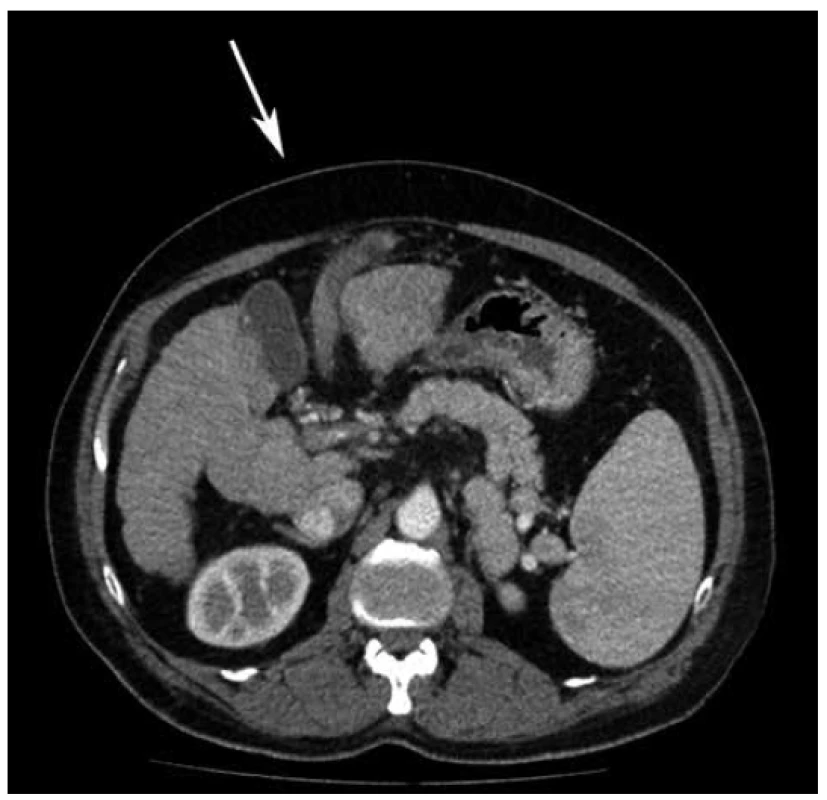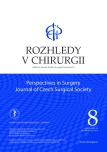An unusual presentation of epigastric pain due to thrombophlebitis of a recanalised umbilical vein – case report
Neobvyklý případ bolesti v epigastriu kvůli tromboflebitidě rekanalizované umbilikální žíly – kazuistika
Úvod: K rekanalizaci umbilikální žíly může dojít díky portální hypertenzi u pacientů s jaterní cirhózou. Tento stav je však jen vzácně klinicky významný. Krvácení z této zvětšené žíly je známou komplikací, avšak nález tromboflebitidy této žíly nebyl v minulosti v literatuře popsán.
Kazuistika: Přinášíme kazuistiku 62 letého muže s anamnézou alkoholové jaterní cirhózy, který byl přijat do nemocnice pro bolest v epigastriu. CT vyšetření pacientova břicha prokázalo trombus s okolními zánětlivými změnami v rekanalizované umbilikální žíle. Pacient byl léčen konzervativně a následujícího dne byl propuštěn z nemocnice domů.
Závěr: Tromboflebitida rekanalizované umbilikální žíly je vzácnou příčinnou bolesti břicha u pacientů pacientů s jaterní cirhózou.
Klíčová slova:
umbilikální žíla – tromboflebitida
Authors:
J. Chmelo; B. Dent; N. Newton; P. Coyne
Authors place of work:
Royal Victoria Infirmary, Newcastle Upon Tyne Hospitals NHS Foundation Trust, United Kingdom
Published in the journal:
Rozhl. Chir., 2019, roč. 98, č. 8, s. 326-327.
Category:
Kazuistika
doi:
https://doi.org/10.33699/PIS.2019.98.8.326–327
Summary
Introduction: The umbilical vein can become recanalised due to portal hypertension in patients with liver cirrhosis but the condition is rarely clinically significant. Although bleeding from this enlarged vein is a known complication, the finding of thrombophlebitis has not been previously described.
Case report: We report the case of a 62-year-old male with a history of liver cirrhosis due to alcoholic liver disease presenting to hospital with epigastric pain. A CT scan of the patient’s abdomen revealed a thrombus with surrounding inflammatory changes in a recanalised umbilical vein. The patient was managed conservatively and was discharged home the following day.
Conclusion: Thrombophlebitis of a recanalised umbilical vein is a rare cause of abdominal pain in patients with liver cirrhosis.
Keywords:
umbilical vein – thrombophlebitis
INTRODUCTION
In adults, recanalisation of the umbilical or paraumbilical vein may occur due to liver cirrhosis [1]. These veins are prone to develop complications, commonly bleeding [2,3,4,5]; however, thrombophlebitis of a recanalised umbilical vein has not previously been reported in adults. We report a case of a patient presenting with epigastric pain due to this condition.
CASE REPORT
A 62-year-old male presented to hospital with a two-day history of epigastric pain and jaundice. There were no other associated symptoms. Past medical history included alcoholic liver disease and hepatitis C with subsequent cirrhosis and hepatocellular carcinoma (T1N0M0), treated with resection and microwave ablation. At the time of presentation, he had been abstinent from alcohol for several years and was under follow–up with the hepatology team. On examination the patient was haemodynamically normal, apyrexial, jaundiced and was tender in the epigastrium but not peritonitic. There were no dilated periumbilical veins visible. Blood analysis revealed chronically deranged liver function tests and a low platelet count. The white blood cell count was normal and C-reactive protein was 30. A CT scan of the abdomen was performed. This revealed known liver cirrhosis with portal hypertension, a new thrombus in the SMV and portal vein and thrombophlebitis of a recanalised umbilical vein corresponding to the site of pain [Fig. 1]. An incidental small new lesion in the liver was also seen which was thought to be a recurrent HCC. Following discussion with hepatology and haematology teams the patient was managed conservatively with simple analgesia. The patient was discharged home the following day.

DISCUSSION
Thrombophlebitis of a recanalised umbilical vein is a rare cause of abdominal pain. The umbilical vein carries oxygenated blood from the placenta and drains into the portal vein system of the fetus; it normally closes shortly after birth. Recanalisation of this vessel can happen when there is an increased pressure in the portal vein system, for example in patients with liver cirrhosis. This portosystemic shunt can lead to appearance of the classic caput medusa sign caused by dilated periumbilical veins. A recanalised umbilical vein is usually an incidental finding on imaging and is of low clinical significance. Complications from recanalised umbilical or paraumbilical veins are rare. Haemorrhage into the peritoneal cavity can be life threatening and necessitate operative management [2]. Patients may also develop external bleeding [3,5] with one case report describing percutaneous embolisation of the umbilical vein [4]. Thrombus formation in a recanalised umbilical vein has been described in a patient with acute pancreatitis and non-cirrhotic liver [6] and hence complications in this vein are not necessarily limited to patients with cirrhosis. Thrombosis of paraumbilical vein could be a contributing factor to necrosis of the falciform ligament [7]. Thrombophlebitis of a recanalised umbilical vein has not previously been described. An inflammation of the vein due to thrombus formation is more commonly seen in lower extremities but theoretically could appear in any vein with venous stasis. In the case we describe, the thrombophlebitis led to pain in the epigastric area where the umbilical vein is located. Superficial thrombophlebitis is usually managed symptomatically; prevention of subsequent clot complications may be needed in high risk patients. Venous stasis and malignancy are recognised risk factors for venous thromboembolism, which were both present in this case. Anticoagulation was considered; however, due to the history of chronic liver disease with impaired coagulation this was deemed inappropriate.
Conflict of interests
The authors declare that they have no conflict of interest in connection with this paper and that the article has not been published in any other journal.
MUDr. Jakub Chmelo
Northern Oesophago-gastric Unit,
Royal Victoria Infirmary,
Newcastle Upon Tyne Hospitals NHS
Foundation Trust,
Queen Victoria Rd,
Newcastle upon Tyne, NE1 4LP,
United Kingdom
e-mail:jakub.chmelo@nuth.nhs.uk
Zdroje
- Aagard J, Jensen LI, Sorensen TI, et al. Recanalized umbilical vein in portal hypertension. AJR Am J Roentgenol. 1982;139:1107−10. doi: 10.2214/ajr.139.6.1107.
- Goldstein AM, Gorlick N, Gibbs D, et al. Hemoperitoneum due to spontaneous rupture of the umbilical vein. Am J Gastroenterol. 1995;90:315–7.
- Douglas JG. Umbilical haemorrhage–an unusual complication of cirrhosis. Postgrad Med J. 1981;57:461–2.
- Assis DN, Pollak J, Schilsky ML, et al. Successful treatment of a bleeding umbilical varix by percutaneous umbilical vein embolization with sclerotherapy. J Clin Gastroenterol. 2012;46:115−8. doi: 10.1097/MCG.0b013e31822b7f9a.
- Zachariah SK, Krishnankutty SL, Raja N. Laparoscopic management of massive spontaneous external haemorrhage from the umbilical varix due to recanalisation of the paraumbilical vein in a patient with ‘Child’s Class A’ liver cirrhosis. J Minim Access Surg. 2012;8:54−6. doi: 10.4103/0972-9941.95536.
- Lim HQC, Lee XWJ, Mathias N. A rare finding of falciform ligament thrombosis as a sequel of acute pancreatitis. Case Rep Radiol. 2017. Epub. doi: 10.1155/2017/2879568.
- Ozkececı ZT, Ozsoy M, Celep B, et al. A rare cause of acute abdomen: an isolated falciform ligament necrosis. Case Rep Emerg Med. 2014, Epub. doi: 10.1155/2014/570751.
Štítky
Chirurgie všeobecná Ortopedie Urgentní medicínaČlánek vyšel v časopise
Rozhledy v chirurgii

2019 Číslo 8
- Metamizol jako analgetikum první volby: kdy, pro koho, jak a proč?
- Primární prevence osteoporózy v kostce
- MUDr. Lenka Klimešová: Multioborová vizita může být klíčem k efektivnější perioperační léčbě chronické bolesti
Nejčtenější v tomto čísle
- Injuries of the small and large intestine
- Psychological influences on wound healing
- Long-term patient follow-up after post-kidney transplant symptomatic lymphocele therapy
- Lymphomas and acute abdomen – a set of case reports
